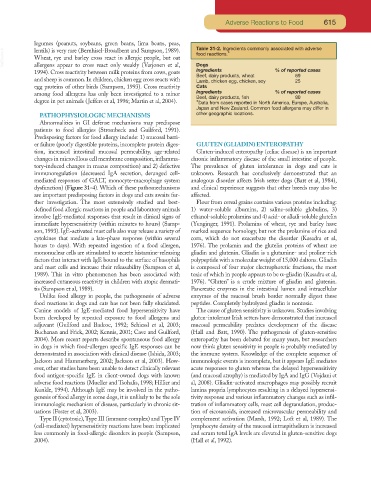Page 593 - Small Animal Clinical Nutrition 5th Edition
P. 593
Adverse Reactions to Food 615
legumes (peanuts, soybeans, green beans, lima beans, peas, Table 31-2. Ingredients commonly associated with adverse
lentils) is very rare (Bernhisel-Broadbent and Sampson, 1989).
VetBooks.ir Wheat, rye and barley cross react in allergic people, but oat food reactions.*
Dogs
allergens appear to cross react only weakly (Varjonen et al,
1994). Cross reactivity between milk proteins from cows, goats Ingredients % of reported cases
and sheep is common.In children,chicken egg cross reacts with Beef, dairy products, wheat 69
25
Lamb, chicken egg, chicken, soy
egg proteins of other birds (Sampson, 1993). Cross reactivity Cats
among food allergens has only been investigated to a minor Ingredients % of reported cases
degree in pet animals (Jeffers et al, 1996; Martin et al, 2004). Beef, dairy products, fish 80
*Data from cases reported in North America, Europe, Australia,
Japan and New Zealand. Common food allergens may differ in
PATHOPHYSIOLOGIC MECHANISMS other geographic locations.
Abnormalities in GI defense mechanisms may predispose
patients to food allergies (Strombeck and Guilford, 1991).
Predisposing factors for food allergy include: 1) mucosal barri-
er failure (poorly digestible proteins, incomplete protein diges- GLUTEN (GLIADIN) ENTEROPATHY
tion, increased intestinal mucosal permeability, age-related Gluten-induced enteropathy (celiac disease) is an important
changes in microvillous cell membrane composition,inflamma- chronic inflammatory disease of the small intestine of people.
tory-induced changes in mucus composition) and 2) defective The prevalence of gluten intolerance in dogs and cats is
immunoregulation (decreased IgA secretion, deranged cell- unknown. Research has conclusively demonstrated that an
mediated responses of GALT, monocyte-macrophage system analogous disorder affects Irish setter dogs (Batt et al, 1984),
dysfunction) (Figure 31-4). Which of these pathomechanisms and clinical experience suggests that other breeds may also be
are important predisposing factors in dogs and cats awaits fur- affected.
ther investigation. The most extensively studied and best- Flour from cereal grains contains various proteins including:
defined food allergic reactions in people and laboratory animals 1) water-soluble albumins, 2) saline-soluble globulins, 3)
involve IgE-mediated responses that result in clinical signs of ethanol-soluble prolamins and 4) acid- or alkali-soluble glutelin
immediate hypersensitivity (within minutes to hours) (Samp- (Yunginger, 1991). Prolamins of wheat, rye and barley have
son, 1993). IgE-activated mast cells also may release a variety of marked sequence homology, but not the prolamins of rice and
cytokines that mediate a late-phase response (within several corn, which do not exacerbate the disorder (Kasadra et al,
hours to days). With repeated ingestion of a food allergen, 1976). The prolamin and the glutelin proteins of wheat are
mononuclear cells are stimulated to secrete histamine-releasing gliadin and glutenin. Gliadin is a glutamine- and proline-rich
factors that interact with IgE bound to the surface of basophils polypeptide with a molecular weight of 15,000 daltons. Gliadin
and mast cells and increase their releasability (Sampson et al, is composed of four major electrophoretic fractions, the most
1989). This in vitro phenomenon has been associated with toxic of which in people appears to be α-gliadin (Kasadra et al,
increased cutaneous reactivity in children with atopic dermati- 1976). “Gluten” is a crude mixture of gliadin and glutenin.
tis (Sampson et al, 1989). Pancreatic enzymes in the intestinal lumen and intracellular
Unlike food allergy in people, the pathogenesis of adverse enzymes of the mucosal brush border normally digest these
food reactions in dogs and cats has not been fully elucidated. peptides. Completely hydrolyzed gliadin is nontoxic.
Canine models of IgE-mediated food hypersensitivity have The cause of gluten sensitivity is unknown. Studies involving
been developed by repeated exposure to food allergens and gluten-intolerant Irish setters have demonstrated that increased
adjuvant (Guilford and Badcoe, 1992; Schiessl et al, 2003; mucosal permeability predates development of the disease
Buchanan and Frick, 2002; Kennis, 2001; Cave and Guilford, (Hall and Batt, 1990). The pathogenesis of gluten-sensitive
2004). More recent reports describe spontaneous food allergy enteropathy has been debated for many years, but researchers
in dogs in which food-allergen specific IgE responses can be now think gluten sensitivity in people is probably mediated by
demonstrated in association with clinical disease (Ishida, 2003; the immune system. Knowledge of the complete sequence of
Jackson and Hammerberg, 2002; Jackson et al, 2003). How- immunologic events is incomplete, but it appears IgE mediates
ever, other studies have been unable to detect clinically relevant acute responses to gluten whereas the delayed hypersensitivity
food antigen-specific IgE in client-owned dogs with known (and mucosal atrophy) is mediated by IgA and IgG (Vojdani et
adverse food reactions (Mueller and Tsohalis, 1998; Hillier and al, 2008). Gliadin-activated macrophages may possibly recruit
Kunkle, 1994). Although IgE may be involved in the patho- lamina propria lymphocytes resulting in a delayed hypersensi-
genesis of food allergy in some dogs, it is unlikely to be the sole tivity response and various inflammatory changes such as infil-
immunologic mechanism of disease, particularly in chronic sit- tration of inflammatory cells, mast cell degranulation, produc-
uations (Foster et al, 2003). tion of eicosanoids, increased microvascular permeability and
Type II (cytotoxic),Type III (immune complex) and Type IV complement activation (Marsh, 1992; Loft et al, 1989). The
(cell-mediated) hypersensitivity reactions have been implicated lymphocyte density of the mucosal intraepithelium is increased
less commonly in food-allergic disorders in people (Sampson, and serum total IgA levels are elevated in gluten-sensitive dogs
2004). (Hall et al, 1992).

